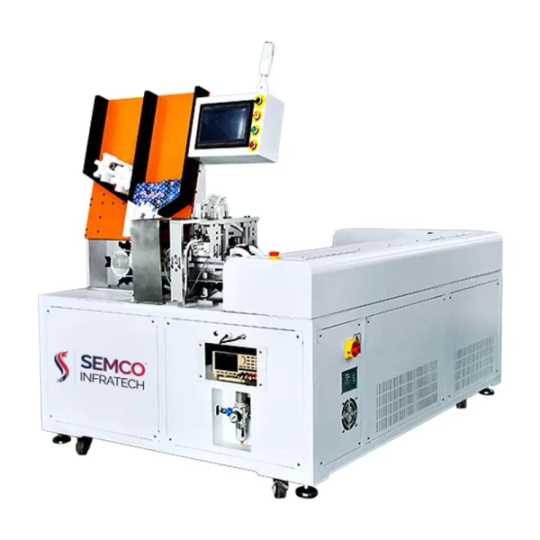#Cylindrical Cell Sorting and Sticker Pasting Machines
Explore tagged Tumblr posts
Text
#Sorting and Sticker pasting machine for cylindrical batteries#Cylindrical Battery Cell Sorting and Sticker Pasting Machine#Sorting and Sticker Pasting Machines Manufacturer for Cylindrical Cell in India#Cylindrical Cell Sorting and Sticker Pasting Machines for Lithium Ion Batteries#Cylindrical Cell Sorting and Sticker Pasting Machines
1 note
·
View note
Text

Optimize cylindrical cell processing with efficient sorting and sticker pasting machines designed for accuracy and speed in battery production.
#sorting and sticker pasting machines#sorting & sticker pasting machines#sorting and sticker pasting machines for cylindrical cell#sorting & sticker pasting machines for cylindrical cells
0 notes
Text
How Cylindrical Cell Sorting Ensures Quality and Consistency in Production?
In today’s tech-driven world, batteries work like a powerhouse of every device we use. One thing that we must understand is that behind the sleek exteriors and impressive capacities lies a crucial step: cell sorting. As a large number of batteries around there are made from cylindrical cells this time, we will also be focusing on Cylindrical Battery Cell Sorting and Sticker Pasting Machine.
This might sound simple, but it’s a highly technical process that ensures consistency and quality in the batteries. Let’s delve into the fascinating world of cell sorting and explore how manufacturers use it to create reliable and high-performing batteries.
Cell sorting, also known as battery cell grading, goes far beyond simply separating used batteries from new ones. It’s a meticulous process that involves evaluating individual battery cells based on a set of critical criteria. These criteria determine the health, capacity, and overall performance potential of each cell.
Imagine a group of students preparing for an exam. Cell sorting acts like a detailed assessment, analyzing each cell’s capabilities and assigning them “grades” based on their performance.

Criteria and Standards
So, what exactly do manufacturers look for when sorting cylindrical cells? Here are some key criteria:
State of Health (SOH): This metric indicates the remaining capacity of a cell compared to its original capacity when new. It’s like a battery’s “fuel gauge,” reflecting how much power it can still hold.
Internal Resistance: This measures the opposition a cell presents to the flow of current. Higher resistance translates to a loss of energy and reduced performance. Think of it as friction in a car engine; the lower the friction, the smoother the ride.
Voltage and Current Performance: These parameters determine the cell’s ability to deliver power. A cell with consistent voltage and high current output is a reliable performer, ensuring constant power delivery.
Physical Characteristics: Manufacturers also perform visual inspections to identify any physical damage like dents or leaks. Even minor imperfections can compromise safety and performance.
These criteria are often used in conjunction with established industry standards. These standards, set by organizations like the International Electrotechnical Commission (IEC), ensure consistency and reliability across different battery manufacturers.
Testing the Inner Workings of a Cell
To evaluate these criteria, battery manufacturing equipment suppliers provide machines for specific tasks. Some of the prominent tests and methods employ a range of sophisticated testing techniques. Here are some prominent methods:
Electrochemical Impedance Spectroscopy (EIS): This non-destructive method measures a cell’s internal resistance by analyzing its response to a small electrical signal. It provides a detailed picture of the cell’s health and performance potential.
Galvanostatic Charge-Discharge (GCD): This test involves charging and discharging a cell at a specific current to determine its actual capacity. It paints a real-world picture of how much power the cell can deliver.
Cycle Testing: This involves repeatedly charging and discharging a cell to simulate real-world usage and assess its lifespan and degradation rate. It helps predict how long the cell will perform reliably.
The specific tests employed can vary depending on the battery type and its intended application. However, the core principle remains the same: to thoroughly analyze each cell and determine its suitability for its intended use.
Technologies Enabling Precision Sorting
Technology plays a crucial role in enabling precise and efficient cell sorting. Here are some key players in the game:
Automated Sorting & Sticker Pasting Machine for Cylindrical Cells: These sophisticated machines can handle large volumes of cells, performing high-speed testing and sorting based on pre-defined criteria. Imagine a robotic assembly line meticulously analyzing and classifying cells.
Machine Learning (ML): Advanced algorithms can analyze data from cell testing to identify patterns and predict a cell’s performance potential. This allows for even more nuanced sorting and optimization.
Artificial Intelligence (AI): AI takes ML a step further, continuously learning and refining cell sorting algorithms. Think of it as a super-powered brain constantly improving the sorting process.
By harnessing these technologies, manufacturers can ensure consistent and reliable cell sorting, leading to superior battery performance.
Consistency and Reliability in Battery Power
So, what does cell sorting translate to in the real world? Here are the key benefits:
Enhanced Battery Performance: By placing cells with similar capacity and performance in a battery pack, manufacturers ensure consistent power delivery and overall performance. A well-sorted battery pack functions like a well-oiled machine, delivering optimal power output.
Improved Safety and Reliability: Identifying and removing cells with potential issues like high internal resistance or physical damage minimizes the risk of safety hazards within a battery pack. It’s like removing faulty parts from a car engine for smoother and safer operation.
Extended Battery Life: Cell sorting helps identify cells with high capacity and low degradation rates. These cells can be used in applications demanding long lifespans.
SMD: Precise cell sorting ensures battery quality and consistency. Sophisticated tech like AI analyses each cell, optimizing performance and safety. A well-sorted battery pack delivers reliable power for all your devices.
#Cylindrical Battery Cell Sorting and Sticker Pasting Machine#battery manufacturing equipment suppliers#Cylindrical Lithium Ion Battery Cell Sorting and Sticker Pasting Machine#Cylindrical Cell Sorting and Sticker Pasting Machine#Cylindrical Cell Sorting and Sticker Pasting Machine for Lithium Ion Batteries#Sorting & Sticker Pasting Machine#Sorting and Sticker Pasting Machine
0 notes